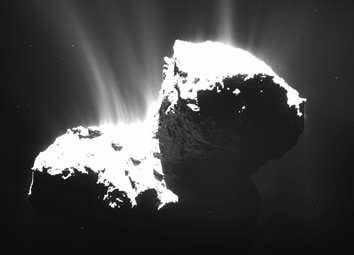Create a free profile to get unlimited access to exclusive videos, sweepstakes, and more!
Comet Close-Ups Reveal an Alien World

After a 10-year voyage, the Rosetta spacecraft entered orbit around the comet 67P/Churyumov–Gerasimenko in August 2014, the first time such an achievement had ever been made. Most of the images made public at the time (and since) were from the wide-angle NAVCAM instrument, and only a handful of the higher-resolution OSIRIS camera pictures were released.
But now the first results from the observations have been published, and quite a few close-up images from OSIRIS have been revealed … and they’re spectacular. The comet is a bizarre, alien place, where our notions of up and down get stymied, and where our “common sense” (from having grown up on a vast, heavy-gravity, be-atmosphered planet) is likely to betray us.
Here are some of those pictures that caught my eye.
To orient you, here is an annotated map of the comet’s surface. It’s shaped overall like a rubber duckie, with the small and large lobes connected by a relatively thin neck. The different regions are separated by overall large-scale appearance, probably due to ongoing processes shaping the comet’s surface. Note the names; Rosetta was named after the Rosetta Stone that allowed linguists to decipher the ancient Egyptian language, so all the features on the comet are named after various Egyptian gods (or possibly Goa’uld).
Comets are basically rocks, gravel, and dust held together by various ices (like water, carbon dioxide, and other things we normally think of as gases). As it nears the Sun, a comet becomes active; the ice turns directly into a gas (called sublimation), dislodging all that other material. 67/P is already becoming active as it nears the Sun. It’s been known that vents over the surface of a comet expel gas as the ice sublimates. The (overexposed) picture above shows depressions in the Seth region, and the center one is actively spewing out jets of gas. Those may look like impact craters, but they’re actually something of the opposite: pits that are growing as the material inside them is blasted out into space. It’s erosion, comet-style.
The comet is in the hard vacuum of space, so you probably wouldn’t expect to see wind-driven features on the surface … but that’s just what the above picture appears to show! Those ripples in the surface look very much like dunes. The obvious culprit is a temporary wind blown as the ice sublimates, the resulting gas streaming away and pushing surface material (probably very fine dust) around. That may be what formed these features, but right now scientists aren’t sure. Other features also indicate winds shaped them, too.
I found myself particularly drawn to this photo, showing the Imhotep region. The smooth floor looks like ponding, where flowing material builds up in a depression. This is seen on the Moon, for example, but it’s usually from ancient lava flows. In this case, it’s likely to be dust that’s built up. Note in the upper left there’s an area at slightly higher elevation that’s also smooth; did the material flow down from there? On the right is a steplike feature, probably built up from multiple ponding events. It’s unclear what could do this; seismic activity as the comet expands and contracts thermally? An impact from a small asteroid whacking the surface hard enough to create a cometquake? Particularly violent eruptions as new ice pockets are exposed to the Sun?
The comet spins once every 12 hours, and the rotation axis goes through the neck in such a way that the lobes go around each other, end over end. This may be why there’s a huge crack, more than 500 meters long, in the neck of the comet! It extends from Hapi into Anuket, at one point disappearing and reappearing again farther along. This indicates it’s a large-scale feature.
Is the comet in danger of splitting in two? Comets do fall apart, sometimes even disintegrating completely, so it’s entirely possible this fate awaits 67/P. Measurements by Rosetta indicate the comet has a very low density, suggesting it’s porous, more like a loosely bound collection of rubble than a solid body. It’s hard to say what will happen as it erodes away, spilling its guts to space as it passes the Sun over and again.
The beauty of all this is that this adventure has just begun! The comet is still inbound, getting closer to the Sun, and the primary mission of Rosetta will last at least a year, tagging along to watch the comet change as it nears our star. It’s expected to become more active as it does so, outgassing more. Will this change the features we’ve already seen? I expect it will, and I’m eagerly awaiting more images of these regions, so we can see the incredible forces shaping this tiny—and extremely weird—world.
Related Posts:
10 Things You Don’t Know About Comets
Here’s What a Comet Looks Like When You’re Close Enough to Touch It (gallery of stunning comet photos)
Rosetta Arrives at a Comet!
Rosetta’s Comet Sprouts a Jet
Philae Spotted Hopping Away in Photo of Comet














